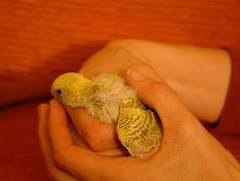Adult Navanax
-
An adult Navanax, crawling across a float on kelp, near Portuguese Rock off
Anacapa. The sensory organs they extend in front, and the eyes atop the
mantle,...
9 years ago
A blog about a flock of budgies: Sutcliffe, the white and blue pater familias, originally a budgie bin budgie who has come a million miles, Mary Ann, a completely yellow (lutein) shelter budgie who is a lovely plump diva, and their two wild type (green) offspring, Boo, and Magoo. We also have a cat, Shania (added much more recently, 7-09).
 Budgie social behavior clearly has defined distances that are acceptable. About one and one half a budgie length is a comfortable distance. Getting closer than less than one budgie length to another bird signifies a "one of us is gonna hafta move" action. This seems to be true horizontally, vertically, and diagonally. Who makes whom move helps sort out the pecking order. In the aviary, very little true pecking goes on, as happened in a smaller cage. There is plenty of perch space, food bowls, at several different levels. Sutcliffe and Mary ann stay much closer to each other than this, as a breeding pair. He is always feeding her and hopping to be near her. It is also important not to be directly under anyone else. I suspect that this is for two reasons; 1. if you are right under someone else, you might get crapped on, literally. 2. having something on top means you can be swooped down upon and pinned, not a good thing for a tiny budgie who could serve as food for a larger bird of prey. Hiding in a thicket, though, with loose twigs above seems to be copacetic, once again for fairly obvious reasons--it would be very hard to swoop down and trap a budgie who was in a thicket. Also, climbing into a collection of twigs and pulling at them to tear them apart brings great joy to the budgies. It may help them keep their beaks groomed. Also, it probably is instinctually a good way to forage.
Budgie social behavior clearly has defined distances that are acceptable. About one and one half a budgie length is a comfortable distance. Getting closer than less than one budgie length to another bird signifies a "one of us is gonna hafta move" action. This seems to be true horizontally, vertically, and diagonally. Who makes whom move helps sort out the pecking order. In the aviary, very little true pecking goes on, as happened in a smaller cage. There is plenty of perch space, food bowls, at several different levels. Sutcliffe and Mary ann stay much closer to each other than this, as a breeding pair. He is always feeding her and hopping to be near her. It is also important not to be directly under anyone else. I suspect that this is for two reasons; 1. if you are right under someone else, you might get crapped on, literally. 2. having something on top means you can be swooped down upon and pinned, not a good thing for a tiny budgie who could serve as food for a larger bird of prey. Hiding in a thicket, though, with loose twigs above seems to be copacetic, once again for fairly obvious reasons--it would be very hard to swoop down and trap a budgie who was in a thicket. Also, climbing into a collection of twigs and pulling at them to tear them apart brings great joy to the budgies. It may help them keep their beaks groomed. Also, it probably is instinctually a good way to forage.





